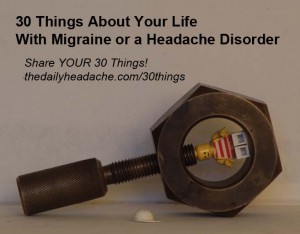 Your early response to the 30 Things meme is so exciting! I love learning about how you all cope with migraine, CDH, and NDPH and know that other readers will learn much from you (and hope people with other headache disorders will be represented, too). Some responses have even brought me to tears, like:
Your early response to the 30 Things meme is so exciting! I love learning about how you all cope with migraine, CDH, and NDPH and know that other readers will learn much from you (and hope people with other headache disorders will be represented, too). Some responses have even brought me to tears, like:
“My life is not defined by my migraine disorder. Though it is a daily part of my life, I refuse to give it the upper hand. I demand that, if it is going to take from me, and it does, it will also give to me – wisdom, strength, faith, and compassion to walk this life better than I was before it came along.” —Take & Give
This reader’s insistence on gaining something from migraine is a wise approach to retaining the upper hand. So often, refusing to give the upper hand is synonymous with barging through life as if in perfect health, which often leads to worsening symptoms. Instead, this reader recognizes the loss and limitation of having migraine, but also what can be learned and gained from it. It is wisdom I try to live by, though I’ve never described it so eloquently.
Be sure to check the 30 Things Meme category and Twitter and Facebook for more insight from readers. To keep you from being overwhelmed by 10 times as many posts as usual, reader submissions are not going out by email, in RSS feeds, or on the homepage of The Daily Headache. I’ll be highlighting comments throughout Migraine and Headache Awareness Month, which starts June 1, but there’s no way I’ll be able to share them all with you.
Will you share your 30 things? Here are the instructions and links to questions: Migraine and Headache Disorders 30 Things Meme. You can tell your story and remain anonymous, if you choose. (You need to put your name and email in the form to post, but I’m the only person who will see them and I won’t send you spam.) It’s a great chance for a short reflection on your life with a headache disorder. And, each story has it’s own URL, so you can send the link to friends and family, if you wish.
P.S. I’m putting together a contest from Migraine and Headache Awareness Month and will draw winners from 30 Things submissions. I’ll share details next week.
